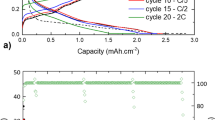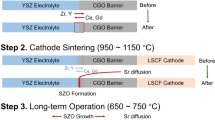Abstract
For present solid oxide fuel cells (SOFCs), rapid performance degradation is observed in the initial aging process, and the discussion of the degradation mechanism necessitates quantitative analysis. Herein, focused ion beam-scanning electron microscopy was employed to characterize and reconstruct the ceramic microstructures of SOFC anodes. The lattice Boltzmann method (LBM) simulation of multiphysical and electrochemical processes in the reconstructed models was performed. Two samples collected from industrial-size cells were characterized, including a reduced reference cell and a cell with an initial aging process. Statistical parameters of the reconstructed microstructures revealed a significant decrease in the active triple-phase boundary and Ni connectivity in the aged cell compared with the reference cell. The LBM simulation revealed that activity degradation is dominant compared with microstructural degradation during the initial aging process, and the electrochemical reactions spread to the support layer in the aged cell. The microstructural and activity degradations are attributed to Ni migration and coarsening.
Similar content being viewed by others
References
S.C. Singhal, and K. Kendall, High-temperature Solid Oxide Fuel Cells: Fundamentals, Design and Applications, Elsevier, New York, 2003.
S.X. Liu, C. Song, and Z.J. Lin, The effects of the interconnect rib contact resistance on the performance of planar solid oxide fuel cell stack and the rib design optimization, J. Power Sources, 183(2008), No. 1, p. 214.
Q.P. Fang, L. Blum, and D. Stolten, Electrochemical performance and degradation analysis of an SOFC short stack following operation of more than 100, 000 hours, J. Electrochem. Soc., 166(2019), No. 16, p. F1320.
A. Hauch and M. Mogensen, Ni/YSZ electrode degradation studied by impedance spectroscopy: Effects of gas cleaning and current density, Solid State Ionics, 181(2010), No. 15–16, p. 745.
S. Koch, P.V. Hendriksen, M. Mogensen, et al., Solid oxide fuel cell performance under severe operating conditions, Fuel Cells, 6(2006), No. 2, p. 130.
H. Sumi, R. Kishida, J.Y. Kim, H. Muroyama, T. Matsui, and K. Eguchi, Correlation between microstructural and electrochemical characteristics during redox cycles for Ni–YSZ anode of SOFCs, J. Electrochem. Soc., 157(2010), No. 12, art. No. B1747.
N. Vivet, S. Chupin, E. Estrade, et al., 3D Microstructural characterization of a solid oxide fuel cell anode reconstructed by focused ion beam tomography, J. Power Sources, 196(2011), No. 18, p. 7541.
H. Iwai, N. Shikazono, T. Matsui, et al., Quantification of SOFC anode microstructure based on dual beam FIB-SEM technique, J. Power Sources, 195(2010), No. 4, p. 955.
G. Brus, K. Miyawaki, H. Iwai, M. Saito, and H. Yoshida, Tortuosity of an SOFC anode estimated from saturation currents and a mass transport model in comparison with a real microstructure, Solid State Ionics, 265(2014), p. 13.
Z.J. Jiao, N. Shikazono, and N. Kasagi, Quantitative characterization of SOFC nickel–YSZ anode microstructure degradation based on focused-ion-beam 3D- reconstruction technique, J. Electrochem. Soc., 159(2012), No. 3, p. B285.
Z.J. Jiao, G. Lee, N. Shikazono, and N. Kasagi, Quantitative study on the correlation between solid oxide fuel cell Ni–YSZ composite anode performance and sintering temperature based on three-dimensional reconstruction, J. Electrochem. Soc., 159(2012), No. 7, p. F278.
Z.J. Jiao and N. Shikazono, Quantitative study on the correlation between solid oxide fuel cell Ni–YSZ composite anode performance and reduction temperature based on three-dimensional reconstruction, J. Electrochem. Soc., 162(2015), No. 6, p. F571.
M. Trini, P.S. Jørgensen, A. Hauch, J.J. Bentzen, P.V. Hendriksen, and M. Chen, 3D microstructural characterization of Ni/YSZ electrodes exposed to 1 year of electrolysis testing, J. Electrochem. Soc., 166(2019), No. 2, p. F158.
M. Trini, A. Hauch, S. De Angelis, X. Tong, P.V. Hendriksen, and M. Chen, Comparison of microstructural evolution of fuel electrodes in solid oxide fuel cells and electrolysis cells, J. Power Sources, 450(2020), art. No. 227599.
X. Yang, Z.H. Du, Q. Zhang, et al., Effects of operating conditions on the performance degradation and anode microstructure evolution of anode-supported solid oxide fuel cells, Int. J. Miner. Metall. Mater., 30(2023), No. 6, pp. 1181–1189.
H. Yakabe, M. Hishinuma, M. Uratani, Y. Matsuzaki, and I. Yasuda, Evaluation and modeling of performance of anode-supported solid oxide fuel cell, J. Power Sources, 86(2000), No. 1–2, p. 423.
L. Chen, A. He, J.L. Zhao, et al., Pore-scale modeling of complex transport phenomena in porous media, Prog. Energy Combust. Sci., 88(2022), art. No. 100968.
K.N. Grew, A.S. Joshi, and W.K.S. Chiu, Direct internal reformation and mass transport in the solid oxide fuel cell anode: A pore-scale lattice boltzmann study with detailed reaction kinetics, Fuel Cells, 10(2010), No. 6, p. 1143.
K.N. Grew, A.S. Joshi, A.A. Peracchio, and W.K.S. Chiu, Porescale investigation of mass transport and electrochemistry in a solid oxide fuel cell anode, J. Power Sources, 195(2010), No. 8, p. 2331.
N. Shikazono, D. Kanno, K. Matsuzaki, H. Teshima, S. Sumino, and N. Kasagi, Numerical assessment of SOFC anode polarization based on three-dimensional model microstructure reconstructed from FIB-SEM images, J. Electrochem. Soc., 157(2010), No. 5, art. No. B665.
D. Kanno, N. Shikazono, N. Takagi, K. Matsuzaki, and N. Kasagi, Evaluation of SOFC anode polarization simulation using three-dimensional microstructures reconstructed by FIB tomography, Electrochim. Acta, 56(2011), No. 11, p. 4015.
T. Shimura, Z.J. Jiao, and N. Shikazono, Evaluation of nickel-yttria stabilized zirconia anode degradation during discharge operation and redox cycles operation by electrochemical calculation, J. Power Sources, 330(2016), p. 149.
Z.W. Lyu, S.X. Liu, Y.G. Wang, et al, Quantifying the performance evolution of solid oxide fuel cells during initial aging process, J. Power Sources, 510(2021), art. No. 230432.
G.J. Nelson, K.N. Grew, J.R. Izzo Jr, et al., Three-dimensional microstructural changes in the Ni–YSZ solid oxide fuel cell anode during operation, Acta Mater., 60(2012), No. 8, p. 3491.
M. Shishkin and T. Ziegler, Oxidation of H2, CH4, and CO molecules at the interface between nickel and yttria-stabilized zirconia: A theoretical study based on DFT, J. Phys. Chem. C, 113(2009), No. 52, p. 21667.
M. Shishkin and T. Ziegler, Hydrogen oxidation at the Ni/yttria-stabilized zirconia interface: A study based on density functional theory, J. Phys. Chem. C, 114(2010), No. 25, p. 11209.
C.S. Cucinotta, M. Bernasconi, and M. Parrinello, Hydrogen oxidation reaction at the NiiYSZ anode of solid oxide fuel cells from first principles, Phys. Rev. Lett., 107(2011), No. 20, art. No. 206103.
S.C. Ammal and A. Heyden, Combined DFT and microkinetic modeling study of hydrogen oxidation at the NiiYSZ anode of solid oxide fuel cells, J. Phys. Chem. Lett., 3(2012), No. 19, p. 2767.
S. Liu, T. Ishimoto, D.S. Monder, and M. Koyama, First-principles study of oxygen transfer and hydrogen oxidation processes at the Ni–YSZ–gas triple phase boundaries in a solid oxide fuel cell anode, J. Phys. Chem. C, 119 (2015), p. 27603.
Acknowledgements
This work was financially supported by the National Key R&D Program of China (No. 2018YFB1502201) and the Guangdong Basic and Applied Basic Research Foundation, China (No. 2020A1515010551). The authors acknowledge Dr. Yu Wang from the Shanghai Institute of Applied Physics for the FIB-SEM test. The numerical calculations in this paper have been done on the supercomputing system in the Supercomputing Center of University of Science and Technology of China.
Author information
Authors and Affiliations
Corresponding author
Ethics declarations
All the authors declare that there is no conflict of interest regarding the publication of this paper.
Rights and permissions
About this article
Cite this article
Liu, S., Liu, Z., Zhang, S. et al. Lattice Boltzmann simulation study of anode degradation in solid oxide fuel cells during the initial aging process. Int J Miner Metall Mater 31, 405–411 (2024). https://doi.org/10.1007/s12613-023-2692-8
Received:
Revised:
Accepted:
Published:
Issue Date:
DOI: https://doi.org/10.1007/s12613-023-2692-8




